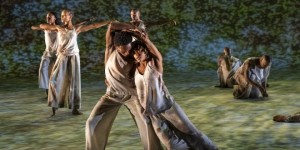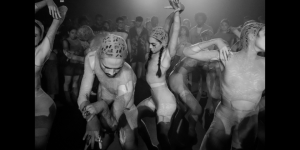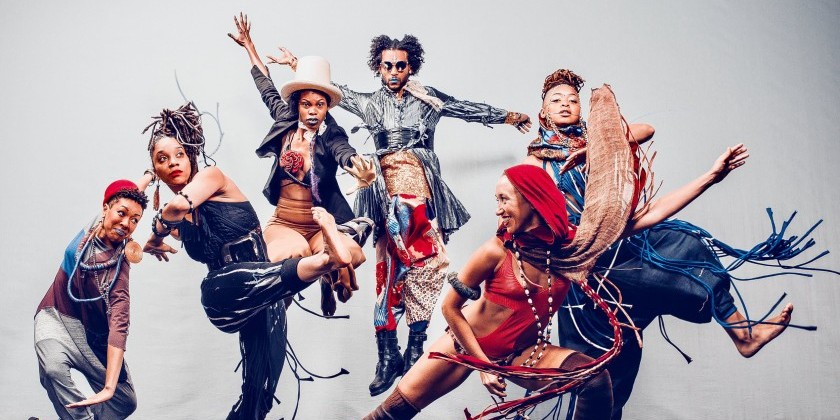IMPRESSIONS: Anne Imhof's "DOOM: House of Hope" at Park Avenue Armory

A Park Avenue Armory Commission
DOOM: House of Hope
By Anne Imhof
Wade Thompson Drill Hall
Anne Imhof, Artist: Direction
Klaus Biesenbach: Curation
sub: Scenography
Josh Johnson: Choreography
Ville Haimala: Music Direction
Mark Grey: Sound Design
Urs Schonebaum: Lighting Design
Eliza Douglas: Assistant Direction, Costume Design
Talia Ryder, Levi Strasser: Playwriting
For cast and character list, click here
March 3 - 12, 2025
Twenty-six gleaming black Cadillac Escalades appear parked ominously on the floor of Wade Thompson Drill Hall in the dimly lit Park Avenue Armory. As if they were a herd of mammoth beasts soon to be snorting and pawing, the gas-guzzling SUVs represent entrenched power. A jumbotron, with an electronic score board, hangs from the center of the ceiling, turning the space into a giant gymnasium. It reads 3:00:00 in big, red numbers, indicating the runtime of German artist Anne Imhof's three-hour-long DOOM: House of Hope, that her company performed March 3 to 12, 2025. (The countdown may also imply the world’s approaching end).

The audience is held behind neck-high concert barriers, as the futuristically back-lit international cast of 40, steps into the space from the Lexington Avenue side of the building. (The Armory fills a square block from Park to Lexington Avenues between 66th and 67th Streets.) Soon, the young performers, dressed in stylized grunge, punk, and athletic gear, disperse. Some climb atop scaffolded cars, the car roofs acting as raised stages. Others crawl silently, stand defiantly, prowl, or ride on skateboards moving ever closer to the audience. Recorded wolf howls punctuate the loud industrial music. To articulate the predatory aspect, “Wolves” is printed on sports uniforms, as well.

Over the din, a tall, hooded figure, The Revolutionary, moves back and forth, gesturing wildly and screaming. Momentarily, the electronica subsides, and recorded bird song and piano music soothes. Then, suddenly, cast members hurl themselves onto the stanchions. The smell of cigarettes wafts from their clothes as they push aside the barriers, and the 1,000-member audience creeps in tentatively. Imhof frequented Frankfurt night clubs while in her 20s (she is 47 now) and this production imitates that underground ambiance.

DOOM revolves around William Shakespeare’s 16th-century tragedy Romeo and Juliet. The subtitle, House of Hope, refers to the houses of Montague and Capulet. However, in DOOM’s dystopian world, the play travels backward. Romeo and Juliet commit suicide at the beginning of the performance, as if to say, get the death out of the way, and then we can live in happiness. These teenaged love birds from the Elizabethan era contrast with the angry, brawling mob that represents our declining society, and potentially cataclysmic future.

Imhof’s adaptation brings forth the younger generations’ belief that the dire reality of climate change, right-wing dictatorships, eroding freedoms, and the pervasiveness of technology and AI will doom civilization. Gangs of performers march through the space like the Wehrmacht, chanting, “We’re doomed. We hope. We’re fucked. We’re dead. I think I made you up inside my head.” They slide fingers down their cheeks tracing imaginary tears, or they aim two fingers at their temples threatening to pull the trigger.

Winner of the Venice Biennale’s Golden Lion award in 2017, Imhof continues to collaborate with many of the same artists seen in her previous works. Her muse, artist Eliza Douglas, is an American by birth who grew up in New York City’s Greenwich Village. Douglas is also a Balenciaga model, and she personifies DOOM’s slouchy, androgenous handsomeness. The performers, who resemble brooding, vaping teenagers with torn jeans and long bangs, similarly recall the posturing models seen in Vogue, or strutting on the catwalk.
In contrast, Romeo and Juliet are hippies, both long-haired and wearing beaded jewelry, she also dressed in an ecru peasant blouse. They appear innocent, tender, and intimate. Sihana Shalaj, the latest female runway star, is cast as Romeo, too. They live in utopian 70s hopefulness. (In a photo found on the internet, Imhof has pulled aside her shirt to reveal the tattooed word, “Eliza” over her heart. When all else fails, there’s always love to hang our hats on.)

The action takes place in several sites onstage. These include a large, circular mat below the jumbotron where Flexn and ballet dancers perform. On the jumbotron screens, we see performers located in private, offstage rooms ‘self-harming’ their faces and bodies with hot wax and live tattooing. Digital graphics scroll by in bold red, delivering messages such as “I MYSELF HAVE THE POWER.” On the south side, a four-piece punk band plays; and there are two lofts near the ceiling on either end where Romeo and Juliet make out, and where other performers keep watch like Big Brother. The crowded audience follows the action, milling among the cars, sometimes following performers, and made aware of the next event by lighting and sound.

Because scenes overlap, it is impossible to view them all. However, two scenes particularly catch my eye. In one, performers dressed in Hogwarts-type school uniforms sit stock-still next to others in “Wolves” uniforms staring straight-faced at the audience, who, in turn, stare back. In the other, a woman pianist accompanies recorded readings of dance critics’ writings and obituaries. After the readings, the pianist, who also wears a school uniform, lies on the circular stage together with a performer costumed as a bear.

The dancing, contemporary and Flexn, in the first three-quarters of DOOM is gnarled and extreme, with occasional ballet movements woven in. Over time, the disturbing elements are pared away, and the movement becomes upright and balanced. The negative overrides the positive until around 00:27:00, when Imhof turns fully to traditional ballet to pay tribute to love.
Tchaikovsky’s Serenade for Strings is piped loudly through the space. Dancers from American Ballet Theatre, including ABT principal Devon Teuscher who plays Romeo, then perform a short excerpt from George Balanchine’s ballet Serenade, as well as sequences by other ballet choreographers including John Cranko and Jerome Robbins. We’ve been released from the cavalier attitude of disaffected youth and from an ‘end of the world’ scenario, and have entered the leotarded purity of ballet heaven. We’ve gone from overwrought darkness to pure, unadulterated light. A figurative tiara crowns DOOM.

The short finale features the discontented and rebellious youth and the ballet dancers on stage together performing a few simple movements. By coming together before the clock runs down, the two groups overcome their differences and metaphorically hold hands. Resorting to Polyannaism, Imhof squanders an opportunity to comment fully on what happens when democratic ideals erode. Her native Germany fell into fascism and suffered for decades. Imhof creates a world of discontent over which hangs a dark cloud, but then, without further commentary, she plops in a staid, though beautiful artform, the ballet. Borrowed clips of famous ballet choreography supply an easy-to-grab, aesthetic conclusion. In the end, love is all that matters. As a beguiling and splendidly crafted spectacle, DOOM holds promise, but ultimately, it's facile ending disappoints.

CAST DETAILS:












